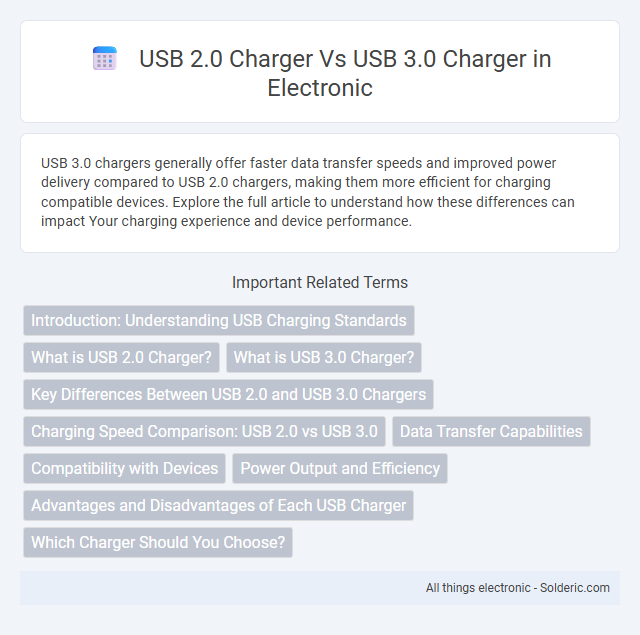USB 3.0 chargers generally offer faster data transfer speeds and improved power delivery compared to USB 2.0 chargers, making them more efficient for charging compatible devices. Explore the full article to understand how these differences can impact Your charging experience and device performance.
Comparison Table
| Feature | USB 2.0 Charger | USB 3.0 Charger |
|---|---|---|
| Max Power Output | 2.5W (5V, 0.5A) | 4.5W (5V, 0.9A) |
| Data Transfer Speed | 480 Mbps | 5 Gbps |
| Cable Compatibility | Works with USB 2.0 cables | Works with USB 3.0 and backward compatible with USB 2.0 cables |
| Charging Efficiency | Lower due to lower current | Higher due to increased current capacity |
| Connector Color | Usually Black or White | Usually Blue |
| Backward Compatibility | Supports USB 1.1 devices | Supports USB 2.0 and USB 1.1 devices |
Introduction: Understanding USB Charging Standards
USB 2.0 chargers typically provide a maximum current of 500mA at 5 volts, resulting in a power output of 2.5 watts, suitable for basic charging needs. USB 3.0 chargers can deliver up to 900mA at 5 volts, equating to 4.5 watts of power, enabling faster charging for compatible devices. Understanding these differences is crucial for selecting the right charger to optimize charging speed and device compatibility.
What is USB 2.0 Charger?
A USB 2.0 charger provides power based on the USB 2.0 standard, delivering up to 500mA of current at 5 volts, which equals 2.5 watts of power. This charging capability supports most basic smartphones and smaller electronic devices but may result in slower charging times compared to newer standards. Unlike USB 3.0 chargers that can provide higher current and faster data transfer, USB 2.0 chargers are primarily designed for standard power output and compatibility.
What is USB 3.0 Charger?
A USB 3.0 charger supports faster data transfer rates up to 5 Gbps compared to USB 2.0's 480 Mbps, enabling quicker syncing and charging when connected to compatible devices. It delivers higher power output, often reaching 900mA (0.9A) or more, which can reduce your device's charging time significantly. Understanding the capabilities of a USB 3.0 charger helps optimize your charging setup for improved efficiency and performance.
Key Differences Between USB 2.0 and USB 3.0 Chargers
USB 3.0 chargers offer significantly faster data transfer rates up to 5 Gbps, compared to USB 2.0's 480 Mbps, enabling quicker device syncing and charging. USB 3.0 ports provide more power output, typically up to 900mA, facilitating faster charging for compatible devices, whereas USB 2.0 ports supply a maximum of 500mA. The physical design of USB 3.0 connectors includes additional pins for enhanced performance, differentiating them from the simpler configuration of USB 2.0 chargers.
Charging Speed Comparison: USB 2.0 vs USB 3.0
USB 3.0 chargers provide significantly faster charging speeds compared to USB 2.0 chargers due to higher current output capabilities, typically delivering up to 900mA versus USB 2.0's 500mA. This 80% increase in current allows devices to charge more quickly and efficiently with USB 3.0 technology. Moreover, USB 3.0 supports improved power management features, enhancing overall charging performance and reducing time to full battery.
Data Transfer Capabilities
USB 2.0 chargers support data transfer speeds up to 480 Mbps, suitable for basic syncing and charging tasks. USB 3.0 chargers enable significantly faster data transfer rates of up to 5 Gbps, facilitating quicker file transfers and efficient device communication. Enhanced bandwidth in USB 3.0 reduces transfer times for large multimedia files and improves overall connectivity performance.
Compatibility with Devices
USB 2.0 chargers offer broad compatibility with most devices due to their standardized 5V output, ensuring reliable charging for smartphones, tablets, and accessories. USB 3.0 chargers, while designed to support higher data transfer speeds, maintain backward compatibility with USB 2.0 devices but may provide enhanced power delivery for newer gadgets. Your choice between USB 2.0 and USB 3.0 chargers should consider device requirements to ensure optimal charging performance.
Power Output and Efficiency
USB 3.0 chargers typically provide higher power output than USB 2.0 chargers, supporting up to 900 mA compared to USB 2.0's 500 mA, which enhances charging speed for compatible devices. The increased efficiency in USB 3.0 stems from improved power management and reduced energy loss, resulting in faster and more reliable charging. Devices utilizing USB 3.0 chargers experience optimized power delivery, especially beneficial for power-hungry gadgets like smartphones and tablets.
Advantages and Disadvantages of Each USB Charger
USB 3.0 chargers offer faster data transfer speeds up to 5 Gbps and deliver higher power output, supporting quicker device charging compared to USB 2.0 chargers, which typically provide up to 480 Mbps data transfer and 2.5 watts of power. The advantage of USB 2.0 chargers lies in their broad compatibility with older devices and lower cost, but they are limited by slower charging rates and reduced data handling capabilities. USB 3.0 chargers can be bulkier and more expensive, yet they are essential for high-speed data transfer and rapid charging of modern gadgets.
Which Charger Should You Choose?
Choosing between a USB 2.0 charger and a USB 3.0 charger depends on your device's charging speed requirements and compatibility. USB 3.0 chargers offer faster charging and data transfer rates up to 5 Gbps, making them ideal for newer devices that support quick charging technology. If your priority is efficient power delivery and future-proofing your setup, a USB 3.0 charger is the better choice for your needs.
USB 2.0 charger vs USB 3.0 charger Infographic

 solderic.com
solderic.com